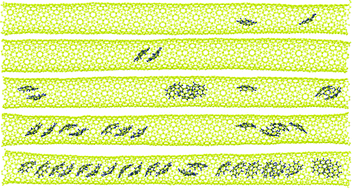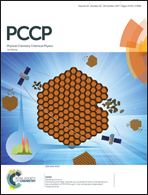Dynamic encapsulation of corannulene molecules into a single-walled carbon nanotube
Abstract
The morphology of corannulene molecules encapsulated in a single-walled carbon nanotube (SWCNT) is addressed using atomistic simulations. Firstly, dynamic simulation (DS) of encapsulation of corannulene molecules into a SWCNT is performed using a molecular dynamics (MD) method. It is revealed that corannulene molecules encapsulated in a SWCNT tend to form concave–concave (CC) dimers, and these dimers make stacks tilting against the SWCNT axis or take an arrangement such that their convex surfaces face the inner wall of the SWCNT. This tendency arises from the fact that the van der Waals interactions between the convex surfaces of the corannulene molecules and the inner wall of the SWCNT dominate in their dynamic encapsulation into the SWCNT, and CC dimers are favored based on the energetics. Next, conjugate gradient (CG) energy minimizations starting from two kinds of initial arrangement of corannulene molecules in a SWCNT, concave–convex (CV) and CC/convex–convex (VV) arrangements, are performed. The CG energy minimizations confirm the result of DS that CC dimers are the structural motif of corannulene molecules in a SWCNT. From the final configurations of both the simulations, the tilt angles and intermolecular distances of the stacked molecules are calculated. With increasing the SWCNT diameter, the tilt angles decrease while the intermolecular distances remain almost constant. The tilt angles of the stacked corannulene molecules are approximately expressed by a semi-analytical formula which is derived on the basis of a geometrical constraint condition.



 Please wait while we load your content...
Please wait while we load your content...